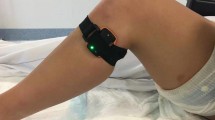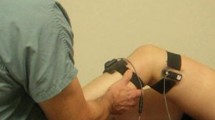Abstract
Purpose
The purposes of the study were to evaluate and to quantify the pivot shift phenomenon by using a small and easy to handle measuring device for pivot shift quantification.
Methods
Twenty patients (forty knees) with primary torn anterior cruciate ligaments (ACL) were tested under anesthesia, graded by the examiner and by the device according to the IKDC classification [normal (0), glide (1), clunk (2), and gross (3)]. For the grading by the device, a femoral and a tibial miniature inertial sensor measured the acceleration and the angular velocities. Three parameters were used for pivot shift identification and quantification: (1) difference between the positive and negative acceleration peak value (a diff), (2) the maximum jerk (j max), and (3) the standard deviation (SD a ) of the acceleration. The ratio between the ACL-deficient and the intact knees was calculated in order to normalize the data.
Results
The pivot shift phenomenon could be identified, and all three parameters showed significant higher values in the ACL-deficient knees compared to the intact knees (p < 0.05). The grading by examiner did not significantly correlate with a diff (p = 0.38; r = 0.21), j max (p = 0.36; r = −0.22), SD a (p = 0.65; r = 0.11), and grading by the device (p = 0.62; r = 0.12).
Conclusions
The present study has shown that the quantification of the pivot shift test is practicable when inertial sensors are used. The results have shown that the subjective grading of the pivot shift test does not correlate well with objective quantification.







Similar content being viewed by others
References
Araki D, Kuroda R, Kubo S, Fujita N, Tei K, Nishimoto K, Hoshino Y, Matsushita T, Matsumoto T, Nagamune K, Kurosaka M (2011) A prospective randomised study of anatomical single-bundle versus double-bundle anterior cruciate ligament reconstruction: quantitative evaluation using an electromagnetic measurement system. Int Orthop 35:439–446
Benjaminse A, Gokeler A, van der Schans CP (2006) Clinical diagnosis of an anterior cruciate ligament rupture: a meta-analysis. J Orthop Sports Phys Ther 36:267–288
Bull AM, Earnshaw PH, Smith A, Katchburian MV, Hassan AN, Amis AA (2002) Intraoperative measurement of knee kinematics in reconstruction of the anterior cruciate ligament. J Bone Joint Surg Br 84:1075–1081
Citak M, Suero EM, Rozell JC, Bosscher MR, Kuestermeyer J, Pearle AD (2011) A mechanized and standardized pivot shifter: technical description and first evaluation. Knee Surg Sports Traumatol Arthrosc 19:707–711
Donaldson WF, Warren RF, Wickiewicz T (1985) A comparison of acute anterior cruciate ligament examinations. Initial versus examination under anesthesia. Am J Sports Med 13:5–10
Hefti F, Müller W, Jakob RP, Stäubli HU (1993) Evaluation of knee ligament injuries with the IKDC form. Knee Surg Sports Traumatol Arthrosc 1:226–234
Hoshino Y, Kuroda R, Nagamune K, Yagi M, Mizuno K, Yamaguchi M, Muratsu H, Yoshiya S, Kurosaka M (2007) In vivo measurement of the pivot-shift test in the anterior cruciate ligament-deficient knee using an electromagnetic device. Am J Sports Med 35:1098–1104
Irrgang JJ, Ho H, Harner CD, Fu FH (1998) Use of the International Knee Documentation Committee guidelines to assess outcome following anterior cruciate ligament reconstruction. Knee Surg Sports Traumatol Arthrosc 6:107–114
Jarvela T (2007) Double-bundle versus single-bundle anterior cruciate ligament reconstruction: a prospective, randomize clinical study. Knee Surg Sports Traumatol Arthrosc 15:500–507
Jonsson H, Riklund-Ahlström K, Lind J (2004) Positive pivot shift after ACL reconstruction predicts later osteoarthrosis: 63 patients followed 5–9 years after surgery. Acta Orthop Scand 75:594–599
Lane CG, Warren RF, Stanford FC, Kendoff D, Pearle AD (2008) In vivo analysis of the pivot shift phenomenon during computer navigated ACL reconstruction. Knee Surg Sports Traumatol Arthrosc 16:487–492
Lopomo N, Zaffagnini S, Signorelli C, Bignozzi S, Giordano G, Marcheggiani Muccioli GM, Visani A (2011) An original clinical methodology for non-invasive assessment of pivot-shift test. Comput Methods Biomech Biomed Engin. doi:10.1080/10255842.2011.591788
Maeyama A, Hoshino Y, Debandi A, Kato Y, Saeki K, Asai S, Goto B, Smolinski P, Fu FH (2011) Evaluation of rotational instability in the anterior cruciate ligament deficient knee using triaxial accelerometer: a biomechanical model in porcine knees. Knee Surg Sports Traumatol Arthrosc. doi:10.1007/s00167-010-1382-z
Magit DP, McGarry M, Tibone JE, Lee TQ (2008) Comparison of cutaneous and transosseous electromagnetic position sensors in the assessment of tibial rotation in a cadaveric model. Am J Sports Med 36:971–977
Musahl V, Bedi A, Citak M, O’Loughlin P, Choi D, Pearle AD (2011) Effect of single-bundle and double-bundle anterior cruciate ligament reconstructions on pivot-shift kinematics in anterior cruciate ligament- and meniscus-deficient knees. Am J Sports Med 39:289–295
Musahl V, Voos JE, O’Loughlin PF, Choi D, Stueber V, Kendoff D, Pearle AD (2010) Comparing stability of different single- and double-bundle anterior cruciate ligament reconstruction techniques: a cadaveric study using navigation. Arthroscopy 26:S41–S48
Noyes FR, Grood ES, Cummings JF, Wroble RR (1991) An analysis of the pivot shift phenomenon. Am J Sports Med 19:148–155
Oberlander MA, Shalvoy RM, Hughston JC (1993) The accuracy of the clinical knee examination documented by arthroscopy. A prospective study. Am J Sports Med 21:773–778
Petersen W, Zantop T (2006) Partial rupture of the anterior cruciate ligament. Arthroscopy 22:1143–1145
Petrie A (2006) Statistics in orthopaedic papers. J Bone Joint Surg Br 88:1121–1136
Siebold R, Branch TP, Freedberg HI, Jacobs CA (2011) A matched pairs comparison of single- versus double-bundle anterior cruciate ligament reconstructions, clinical results and manual laxity testing. Knee Surg Sports Traumatol Arthrosc 19(Suppl 1):4–11
Streich NA, Zimmermann D, Bode G, Schmitt H (2011) Reconstructive versus non-reconstructive treatment of anterior cruciate ligament insufficiency. A retrospective matched-pair long-term follow-up. Int Orthop 35:607–613
Author information
Authors and Affiliations
Corresponding author
Appendix
Appendix
The raw signals underwent some pre-processing before the core analysis started. During pre-processing, the values for acceleration and angular velocity were multiplied with correction matrices to improve the accuracy of the measurements. The signals ran through a finite impulse response (FIR) low-pass filter with a 10 Hz cutoff frequency to clear the signal from noise and other artifacts.
The angle between the sensors on the femur and tibia (knee angle) was calculated with a complex sensor fusion algorithm using accelerometers and gyroscopes. The knee angle was required in order to identify and separate the subsequent test cycles and to specify the region where the pivot shift phenomenon occurred. The Euclidean norm of the acceleration (||a||) was calculated to separate linear acceleration from turnings without linear acceleration. The g-Bias was eliminated by subtracting ||g|| = 9.81 m/s2. The Euclidean norm in the region of the pivot shift had a typical progression as depicted in Figs. 3 and 4. The pivot shift phenomenon was identified due to the local maximum in the Euclidean norm of acceleration. For each of the ten cycles, the Pivot shift phenomenon was identified separately. The moment of the pivot shift phenomenon during testing was called T ps.
Rights and permissions
About this article
Cite this article
Kopf, S., Kauert, R., Halfpaap, J. et al. A new quantitative method for pivot shift grading. Knee Surg Sports Traumatol Arthrosc 20, 718–723 (2012). https://doi.org/10.1007/s00167-012-1903-z
Received:
Accepted:
Published:
Issue Date:
DOI: https://doi.org/10.1007/s00167-012-1903-z




